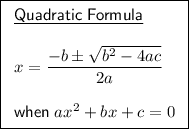Answer:

Explanation:
The area of a right triangle is half the product of its two legs,
 and
and
 :
:

Given values:
To determine the value of x, begin by substituting the values into the area formula:

Multiply both sides of the equation by 2 to eliminate the fraction:

Expand the right side by multiplying x with each term inside the parentheses:

Rearrange the equation into a quadratic equation, setting it equal to zero:

Now, solve this quadratic equation for x by using the quadratic formula:

In this case:
Plug these values into the formula:

Now, calculate the values of x:


As length is positive, the only valid value of x is:


Additional Notes
The decimal value of x, rounded the nearest thousandth, is 9.258.